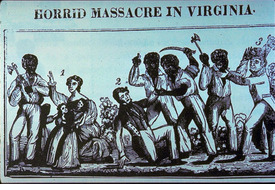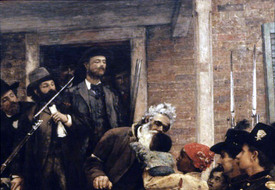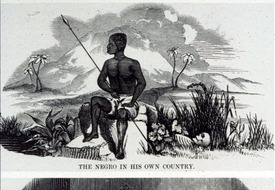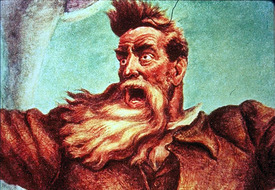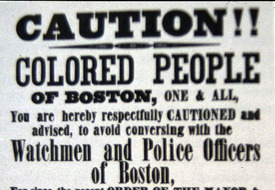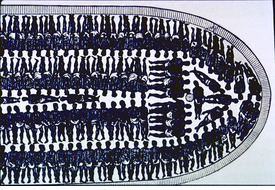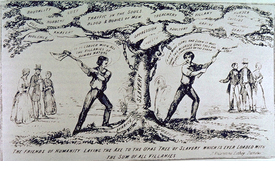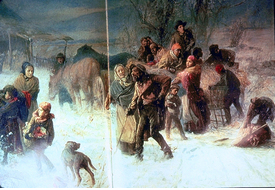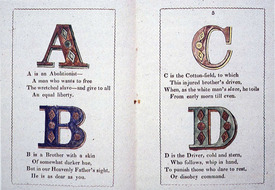
The Antislavery Alphabet, 1847
Image ID: 8351
Collection: Karen Halttunen
Topic(s): Nineteenth Century, Antebellum Reform, Slavery and Abolition, Abolition, Class Separation, Early American Slavery, Institutions and social disorder, Jacksonian Era, Moral lessons, National Politics, Nineteenth Century Slavery, Prejudice and Discrimination, Race, Slavery, Working, and Living Conditions, Southern Society, Symbols, Women's liberation, Women's work
Region(s): United States
CA Standard(s): 8.6 - The divergent paths of the American people from 1800 to the mid-1800s...with emphasis on the Northeast. , 5.8 - The colonization, immigration, and settlement patterns of the American people from 1789 to the mid-1800s..., 8.9 - The early and steady attempts to abolish slavery and to realize the ideals of the Declaration of Independence.
National Standard(s): Expansion and Reform (1801-1861), An Age of Revolutions, 1750-1914
Card Text: "The Antislavery Alphabet" for children, Philadelphia, PA, 1846, from a reader published to be sold at the Anti-Slavery Fair in Philadelphia. The fair was organized by the Philadelphia Female Anti-Slavery Society (PFASS) to raise money for abolition by charging a small admission fee and selling antislavery publications. This popular alphabet book was published anonymously but authorship was later ascribed to Quaker Hannah Townsend (b. 1812), who worked with the PFASS, and her sister Mary (b. 1814). The sisters’ Quaker background encouraged equality between the sexes and likely comforted the Townsends in their activist roles, as educating youth morally was considered a socially acceptable mission for women writers.
This book, like most antislavery and abolitionist texts, was not read in the classroom but in antislavery homes to teach the next generation abolitionist politics and inspire future activism. The woodcuts of each letter, hand-painted and decorated with concentric circles and diamonds, and the simple design of the book, focus the reader on its activist message rather than its artistry.
Using direct, instructive language, the book asks readers to acknowledge the system of slavery and act against it. Its introduction, entitled “To Our Little Readers,” urges children to take part in the abolitionist movement by imploring slave masters, educating peers, and boycotting “[c]andy, sweetmeat, pie or cake” that contained sugar, a slave-cultivated staple. It introduces troubling aspects of slavery, such as cotton-field labor (“C is the Cotton-field, to which / This injured brother’s driven”), corporal punishment (“D is the Driver, cold and stern / Who follows, whip in hand”), and kidnapping (“K is the Kidnapper, who stole / That little child and mother”). In the “Y” quatrain, the reader is told “Bravely to war” against slavery, and the final four lines introduce the young audience to a role model, “the Zealous man, sincere, / Faithful, and just, and true.” Though the text highlights the cruelty of slavery, it also offers hope, depicting an emancipated society in which the free black man is “rambling free” and “Delighting ‘neath the palm trees’ shade.”
The Philadelphia Female Anti-Slavery Society was a racially integrated society founded in 1833 to champion racial and sexual equity. The society first met in Catherine McDermott’s schoolroom in Philadelphia. The constitution they adopted declared slavery and prejudice contrary to the laws of God and the Declaration of Independence. During the 1830s, '40s, and '50s, anti-slavery societies sprang up in cities across the North. Nine of the 42 women who became the society’s charter members were Black, including Charlotte Forten and her three daughters, Harriett D. Purvis, Sarah Louise Forten, and Margaretta Forten. Grace Douglass, Mary Woods, Lydia White, Margaret Bowser, and Sarah McCrummel also signed the charter. Sarah Mapps Douglass joined soon afterward. Black women were instrumental in shaping the group's philosophies and their activism characterized the organization. In 1837, Black Philadelphians Grace Douglass and Sarah Forten joined their white colleagues, Lucretia Mott and three others, to form a six-member board of managers, raising money and coordinating emancipation fairs.
For nine years, 1840 - 49, the society’s education committee, which included several Black members, allocated $120 annually to finance a school taught by Sarah Mapps Douglass. The women also worked with Robert Purvis and other Blacks of the Philadelphia Vigilant Committee by donating money to clothe, feed, and transport enslaved workers fleeing the South. With the end of the Civil War and the ratification of the postwar constitutional amendments, members of the society determined that their work was finished. Resolutions offered at the final meeting of the society on March 21, 1870, celebrated the occasion. “Whereas,” began the resolution proposed by Margaretta Forten, “the object for which this Association was organized is thus accomplished, therefore resolved, that the Philadelphia Anti-Slavery Society, grateful for the part allotted to it in this great work, rejoicing in the victory which has concluded the long conflict between slavery and freedom in America, does hereby disband.” As a model for racial equality and sisterhood for almost four decades, the society’s members could be pleased that their hard work to achieve Black emancipation had been done well. After the Civil War, the society continued to support the cause of the freed slaves.
Citation: The Huntington Library, Art Collections, and Botanical Gardens, 1151 Oxford Rd, San Marino, CA 91108. First text: "The News Media and the Making of America 1730-1865: The Anti-Slavery Alphabet." https://americanantiquarian.org/earlyamericannewsmedia/exhibits/show/news-in-antebellum-america /item/49. American Antiquarian Society, A National Research Library of American Literature, History, and Culture through 1876, 185 Salisbury St, Worcester, MA 01609-1634. Second text: "Mon, 12.09.1833: The Philadelphia Female Anti-Slavery Society is Founded." https://explorepahistory. com/hmarker.php?markerId=1-A-105. Explore PA History.com. Academic.oup.com. The Encyclopedia Britannica, 15th ed. (Copyright 1996 Encyclopedia Britannica, Inc., 325 N LaSalle St, Ste 200, Chicago, IL 60654. All rights reserved.) And African American Registry, PO Box 19441, Minneapolis MN 55419. https://aaregistry.org/story/the-philadelphia-female-anti-slavery-society-founded/. All rights reserved. Jan 17, 2023.
Nat Turner Rebellion, 1831
Image ID: 6379
Collection: Roland Marchand
Topic(s): Black Americans, Black Protest to 1950's, Slavery and Abolition
Region(s): United States
CA Standard(s): 8.7 - The divergent paths of the American people in the South from 1800 to the mid-1800s
National Standard(s): Expansion and Reform (1801-1861)
Card Text: Nat Turner Rebellion, 1831. Illustration published in the Anti-Slavery Almanac of Negro slaves' massacre of whites in Virginia.
Citation: Library of Congress Rare Book and Special Collections Division, Washington, D.C. 20540. LC-USZ62-38902. In Norman A. Graebner, A History of the U.S., Vol. I, 1970, p. 698.
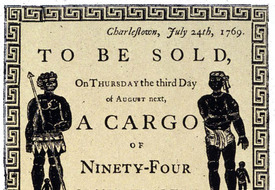
Slave Auction Notice, 1769
Image ID: 6978
Collection: Karen Halttunen
Topic(s): Early American Slavery, Slavery and Abolition, 18th Century Families, 18th Century Portraits, Abolition, Agriculture, Business, Charleston, Colonial America, Columbian Exchange, Developing Nations, Early Ads, Early National Period, Immigrant Societies and Organization, Labor, Market Economy, Nineteenth Century Slavery, Slave Trading, Slavery, Working, and Living Conditions
Region(s): United States, Caribbean, North America
CA Standard(s): 8.7 - The divergent paths of the American people in the South from 1800 to the mid-1800s , 5.4 - Political, religious, social, and economic institutions that evolved in the colonial era. , 5.7 - People and events associated with the development of the U.S. Constitution and it's significance as the foundation of the American republic, 5.8 - The colonization, immigration, and settlement patterns of the American people from 1789 to the mid-1800s..., 7.10 - The historical developments of the Scientific Revolution and its lasting effect on religious, political, and cultural institutions, 7.11 - political and economic change in the sixteenth, seventeenth, and eighteenth centuries (the Age of Exploration, the Enlightenment, and the Age of Reason), 8.1 - Major events preceding the founding of the nation and the development of American constitutional democracy, 8.10 - The multiple causes, key events, and complex consequences of the Civil War
National Standard(s): Colonization and Settlement (1585-1763), Revolution and the New Nation (1754-1820s) , The Emergence of the First Global Age, 1450-1770, An Age of Revolutions, 1750-1914
Card Text: Slave auction notice, Charleston, SC, wharf, 1769. "Charleston, July 24, 1769, To Be Sold. on Thursday, the third Day of August next, a CARGO of ninety-four Prime Healthy Negroes, consisting of thirty-nine Men, fifteen Boys, twenty-four Women, and sixteen Girls. Just arrived, in the Brigantine Dembia, Francis Bare, Master, from Sierra Leone, by David and John Deas." Slave auctioneering was a lucrative business in the colonies. Auctioneers of enslaved Africans were considered regular members of society, their auctions held in public and attended by large crowds. During the colonial period two styles of auction developed. In “grab and go” auctions, purchasers and the auctioneer negotiated a single price for all the slaves. They then met in large pens where the enslaved people were held; the auctioneer threw open the gates, and the purchasers raced in to grab the slaves they wanted. Then they paid the auctioneer the agreed-upon price to leave the pen with the slave. Here is a description of such a sale:
“...I was witness to a sale by scramble, where about 250 Negroes were sold. All the Negroes bear an equal price; which is agreed upon between the captains and the purchasers before the sale begins. On a day appointed, the Negroes were landed and placed together in a large yard belonging to the merchants to whom the ship was consigned. As soon as the hour agreed on arrived, the doors of the yard were suddenly thrown open and in rushed a considerable number of purchasers, with all the ferocity of brutes. Some instantly seized such of the Negroes as they could conveniently lay hold of with their hands. Others being prepared with several handkerchiefs tied together, encircled as many as they were able. While others, by means of a rope, effected the same purpose. It is scarcely possible to describe the confusion....”
In the “Highest Bidder” method, slaves were brought up individually and prospective purchasers were allowed to “inspect” the slave. Enslaved persons were made to walk or jump on stage. Purchasers would inspect teeth and look for hidden injuries. These inspections could even include strip searches. The auctioneer then called out a price that was accepted by willing buyers. The auctioneer continued to call out higher amounts until no one would bid; at that point the purchaser with the highest bid “won” the rights to the enslaved person. Normally, young adult men were the most valuable due to the type of work they were able to do and a typically long life-span. Values would decrease based on factors such as age, gender, perceived health and docility (or likelihood to rebel). A slave described his experience at an auction:
“The gentleman...would make us hold up our heads, walk briskly back and forth, while customers would feel of our hands and arms and bodies, turn us about, ask us what we could do, make us open our mouths and show our teeth, precisely as a jockey examines a horse which he is about to barter for or purchase. Sometimes a man or woman was taken back to the small house in the yard, stripped, and inspected more minutely. Scars upon a slave’s back were considered evidence of a rebellious or unruly spirit, and hurt his sale.”
Citation: American Antiquarian Society, 185 Salisbury St, Worcester, MA 01609-1634. First text: Alexander Falconbridge, "An account of the slave trade on the coast of Africa" (1788), in Thomas Howard, ed., "Black Voyage-Eyewitness Accounts of the Atlantic Slave Trade" (Boston: Little, Brown & Company, 1971). Second text: Solomon Northup, "Twelve Years A Slave" (Auburn, NY: Derby and Miller, 1853) 78–82. Both on Mr. Baker's site, "Slavery." sites.google. com/a/magellancharter.org/8thgrade/mr-baker/slavery. The Magellan Charter School, 9324 Baileywick Rd, Raleigh, NC 27615. Our thanks to Mr. Baker. April 12, 2018.
'Last Moments of John Brown' 1882-1884
Image ID: 9029
Collection: Karen Halttunen
Topic(s): Nineteenth Century, Civil War, Slavery and Abolition
Region(s): United States
CA Standard(s): 8.10 - The multiple causes, key events, and complex consequences of the Civil War
National Standard(s):
Card Text: Thomas Hovenden, "Last Moments of John Brown," 1882-84, oil on canvas, 77 3/8 x 66 1/4 in. (196.5 x 168.3 cm)
Citation: Copyright Metropolitan Museum of Art, 1000 Fifth Ave., New York, NY 10028-0198. Gift of Mr. and Mrs. Carl Stoeckel, 1897 (97.5). http://metmus.org. All rights reserved.
Proslavery propaganda, 1852
Image ID: 8894
Collection: Karen Halttunen
Topic(s): Nineteenth Century, Nineteenth Century Slavery, Slavery and Abolition, Propaganda
Region(s): United States
CA Standard(s): 8.7 - The divergent paths of the American people in the South from 1800 to the mid-1800s
National Standard(s): Civil War and Reconstruction (1850-1877) , Expansion and Reform (1801-1861)
Card Text: Proslavery propaganda: "The Negro In His Own Country" vs. "The Negro In America," from "Bible Defence of Slavery," 1852
Citation: Josiah Priest, "Bible Defence of Slavery," W. S. Brown: Glasgow, KY 1852. Chicago Historical Society, 1601 N Clark St, Chicago, IL 60614
John Brown of Osawatomie, 1937
Image ID: 6585
Collection: Roland Marchand
Topic(s): Abolitionism, Abolition, Slavery and Abolition
Region(s): United States
CA Standard(s): 8.9 - The early and steady attempts to abolish slavery and to realize the ideals of the Declaration of Independence.
National Standard(s): Civil War and Reconstruction (1850-1877)
Card Text: John Steuart Curry painting, "John Brown."
Citation: The State House, Topeka, KS. In American Heritage, Pictorial History of the Presidents of the United States, Vol. I, 1968, p. 372.
8.9.1
Poster: 'Caution!! Colored people of Boston' 1851
Image ID: 11383
Collection: Louis Warren
Topic(s): Slavery and Abolition
Region(s): United States
CA Standard(s): 8.7 - The divergent paths of the American people in the South from 1800 to the mid-1800s
National Standard(s): Civil War and Reconstruction (1850-1877)
Card Text: Poster: "Caution!! Colored people of Boston," a warning against kidnappers and slave catchers, including police officers, 1851, in response to the Fugitive Slave Law of 1850.
Citation: Boston Public Library, 700 Boylston St, Boston, MA 02116.
Slaves on large plantation near Vicksburg, 1863
Image ID: 8924
Collection: Karen Halttunen
Topic(s): Nineteenth Century, Nineteenth Century Slavery, Slavery and Abolition
Region(s): United States
CA Standard(s): 8.7 - The divergent paths of the American people in the South from 1800 to the mid-1800s
National Standard(s):
Card Text: Slaves on large plantation near Vicksburg, MS, July 5, 1863
Citation: Copyright holder unknown. J. Jack Moore Collection, Old Court House Museum, 1008 Cherry St,
Vicksburg, MS 39183
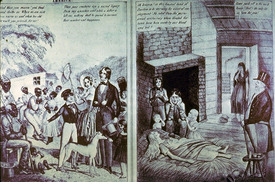
Pro-Slavery Cartoon, 1841
Image ID: 6550
Collection: Roland Marchand
Topic(s): Black Americans, Slavery and Abolition
Region(s): United States
CA Standard(s): 8.7 - The divergent paths of the American people in the South from 1800 to the mid-1800s
National Standard(s): Expansion and Reform (1801-1861)
Card Text: A pro-slavery cartoon, comparing attitudes of England and the American South. The slave is saying, "God bless you, massa! You feed and clothe us. When we are sick you nurse us, and when too old to work, you provide for us!" The slave owner is saying, "These poor creatures are a legacy from my ancestors and while a dollar is left me, nothing shall be spared to increase their comfort and happiness." The British laborer is saying, "Oh heaven! In this boasted land of freedom to be starving from want of employment! No relief from the purse-proud aristocracy whose bloated fortunes have been made by our blood and toil!" The British aristocrat is saying, "Come pack off to the workhouse! That's the only fit asylum for you!" c. 1841.
Citation: Library of Congress Prints and Photographs Division, Washington, DC 20540. LC-USZ62-89745. In Leslie H. Fishel, Jr., and Benjamin Quarles, eds., The Negro American: A Documentary History, Scott, Foresman and Co., 1967, p. 100.
8.7.2
Detail of the interior of a slave ship showing slaves crammed together
Image ID: 6191
Collection: Roland Marchand
Topic(s): Black Americans, Slave Trading, Slavery and Abolition
Region(s): United States
CA Standard(s): 8.7 - The divergent paths of the American people in the South from 1800 to the mid-1800s , 10.4 - Global change in the era of New Imperialism in Africa, Southeast Asia, China, India, Latin America, and the Philippines
National Standard(s):
Card Text: Detail of the interior of a slave ship showing slaves crammed together.
Citation: Library of Congress Rare Book and Special Collections Division, Washington, D.C. 20540. LC-USZ62-44000. In John Hope Franklin, An Illustrated History of Black Americans, 1970, pp. 16-7.
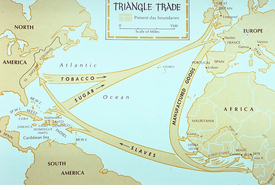
Map: The Triangular Trade, 16th-19th cs.
Image ID: 14119
Collection: Cynthia Brantley
Topic(s): Maps, Trade, Slavery and Abolition
Region(s): Africa, North America, Caribbean, Europe
CA Standard(s): 10.4 - Global change in the era of New Imperialism in Africa, Southeast Asia, China, India, Latin America, and the Philippines, 8.7 - The divergent paths of the American people in the South from 1800 to the mid-1800s
National Standard(s): The Emergence of the First Global Age, 1450-1770, An Age of Revolutions, 1750-1914
Card Text: Map: The Triangular Trade: The trans-Atlantic slave trade began around the mid-15th c. when Portuguese in Africa moved away from the fabled deposits of gold to a much more readily available commodity - slaves. By the 17th c. the trade was in full swing, reaching a peak towards the end of the 18th c. It was a very fruitful trade, since every stage of the journey could be profitable for merchants - the infamous triangular trade. Enslaved Africans were sent to the Americas, American sugar and tobacco to Europe, and European factory goods to Africa, during the late 16th-19th cs. During the colonial era profits from rum and other American and British manufactured goods sold on the west coast of Africa financed the purchase of enslaved Africans. The sale of those slaves in the Americas in turn funded the shipment of sugar, molasses, and other New World raw materials to the point of origin for the manufactured products sold by Europeans in the "new markets" of their African colonies. Rhode Island was the principal mainland American point on the triangle. The economic dislocations caused by the American Revolution disrupted US participation in the Atlantic slave trade. In 1807 Britain outlawed the slave trade altogether, and the US followed suit in 1808. The British navy began to suppress the trade on the high seas. Some slave ships continued to make their way to American ports, but the heyday of the Atlantic slave trade, triangular or otherwise, was over.
Citation: Source unknown. Text: Alistair Boddy-Evans, "The Trans-Atlantic Slave Trade: A review of the triangular trade," African History, ©2011 About.com. Online at http://africanhistory.about.com/od/slavery/tp/TransAtlantic001.htm. All rights reserved.
Cartoon: 'Tree of slavery'
Image ID: 6598
Collection: Roland Marchand
Topic(s): Abolitionism, Abolition, Slavery and Abolition
Region(s): United States
CA Standard(s): 8.9 - The early and steady attempts to abolish slavery and to realize the ideals of the Declaration of Independence.
National Standard(s): Civil War and Reconstruction (1850-1877)
Card Text: Two men chopping down "tree of slavery," J. Valentine, lithograph.
Citation: Leeds Anti-Slavery Series, 1850. In Dwight L. Dumond, Antislavery, 1961, p. 141.
8.9.5
'Underground Railroad' 1893
Image ID: 6602
Collection: Roland Marchand
Topic(s): Abolitionism, Abolition, Slavery and Abolition
Region(s): United States
CA Standard(s): 8.11 - The character and lasting consequences of Reconstruction, 8.7 - The divergent paths of the American people in the South from 1800 to the mid-1800s
National Standard(s): Civil War and Reconstruction (1850-1877)
Card Text: Charles T. Webber, Ohio artist, "Underground Railroad," 1893.
Citation: Copyright The Cincinnati Art Museum, 953 Eden Park Dr, Cincinnati, OH 45202. All rights reserved. In American Heritage, April 1967, p. 22.

